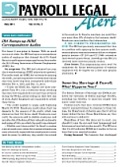 In the waning hours of New Year’s Day, Congress passed a bill averting a plunge off the “fiscal cliff” and setting 2013 tax rates. The overdue legislation means employers can finally begin making solid plans for 2013 payroll operations.
In the waning hours of New Year’s Day, Congress passed a bill averting a plunge off the “fiscal cliff” and setting 2013 tax rates. The overdue legislation means employers can finally begin making solid plans for 2013 payroll operations.
H.R. 8, the American Taxpayer Relief Act of 2012, made permanent Bush-era tax rates for all but the highest earners. That means no tax increase this year for employees taxed at the 10%, 15%, 25%, 28% and 33% rates. President Obama is expected to sign the bill this week.
For individuals earning over $400,000 and married couples earning over $450,000, the top tax rate rises immediately from 35% to 39.6%.
Coincidentally, on Jan. 1, the IRS released the 2013 withholding tables. However, they will now need to be reissued to reflect H.R. 8’s income tax rates.
Congress declined to extend the “payroll tax holiday” economic stimulus, which in 2011 and 2012 lowered employees’ share of the Social Security payroll tax from 6.2% to 4.2%. That means starting Jan. 1, employers must resume withholding at the 6.2% rate.
Advice: Consider notifying employees this week that their take-home pay will shrink slightly, starting with their next paycheck. That’s the result of Congress’ decision to let the payroll tax holiday expire. For example, the 6.2% rate means employees earning $20,000 to $30,000 will pay $406 more per year. Those with incomes of $50,000 to $75,000 will pay $985 more, while those making $100,000 to $200,000 will pay $1,991 more.
Here are the highlights of the changes resulting from passage of H.R. 8.
Income/payroll tax rates
For payroll purposes, the following applies:
- The 25% rate continues to apply as the flat income tax withholding rate on supplemental pay not exceeding $1 million.
- The 28% rate continues to apply as the back-up withholding rate.
- The 35% rate, which was the highest income tax rate and, therefore, was used to withhold income taxes on supplemental pay exceeding $1 million, is no longer the highest income tax bracket.
- A new tax rate of 39.6% is imposed on incomes exceeding $400,000 for singles, $425,000 for heads of household, $450,000 for marrieds filing jointly and $225,000 for marrieds filing separately. Since this rate is now the highest income tax rate, employers must use it to withhold income taxes on supplemental pay exceeding $1 million.
2013 percentage method withholding tables
Also on Jan. 1, the IRS released the 2013 Percentage Method Tables. However, these tables do not reflect H.R. 8’s tax brackets, which means the IRS will need to reissue them promptly.
Flip and flop: Even so, according to the IRS, employers should implement the 2013 tables as soon as possible, but not later than Feb. 15, 2013. Perhaps anticipating Congressional action, the IRS also says that employers should continue to use the 2012 tables until the 2013 tables are implemented, and this may be advisable, since the IRS will certainly need to reissue the tables soon.
Per pay period, the 2013 withholding allowance amounts are:
- Weekly: $75
- Biweekly: $150
- Semimonthly: $162.50
- Monthly: $325
- Quarterly: $975
- Semiannual: $1,950
- Annual: $3,900
- Daily or miscellaneous: $15.
2013 employee Social Security tax rate
H.R. 8 did not continue the lower employee Social Security rate. Accordingly, the employee Social Security rate returns to 6.2%, from 4.2%, for wages paid in 2013. The 2013 Social Security taxable wage base is $113,700, so the maximum employer and employee Social Security tax is $7,049.40.
The IRS says that the 6.2% rate should also be implemented as soon as possible, and not later than Feb. 15, 2013. After implementing the 6.2% rate, employers should make an adjustment in a later pay period to correct any underwithholding of Social Security tax. Underwithholding should be corrected as soon as possible, but not later than March 31, 2013.
Other payroll-related provisions
H.R. 8 also includes the following payroll provisions:
- Employer-provided educational assistance under tax code Section 127 is permanently extended.
- The phase-out of personal exemptions and the overall limitation on itemized deductions are reinstated, and begin at $300,000 for marrieds filing jointly, $275,000 for heads of household, $250,000 for singles, and $150,000 for marrieds filing separately.
- Parity between employer-provided mass transit passes and employer-provided parking (collectively known as qualified transportation fringe benefits) is reinstated retroactive to Jan. 1, 2012, and will expire on Dec. 31, 2013.
- The employer wage credit for employees who are on military leave is extended retroactive to Jan. 1, 2012, and will expire on Dec. 31, 2013.
- The work opportunity tax credit is extended retroactive to Jan. 1, 2012, and will expire on Dec. 31, 2013.
- The earned income tax credit is extended for another five years.
What’s left?
In addition to reissuing the 2013 withholding tables, the IRS must issue the 2013 Form W-4. And, now that parity has been resorted to qualified transportation fringes, the IRS must officially release that amount.

